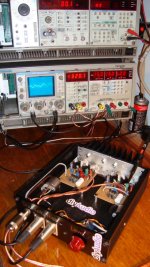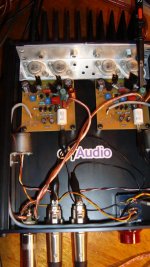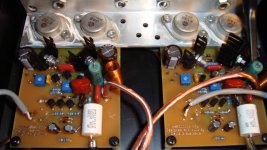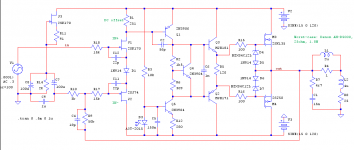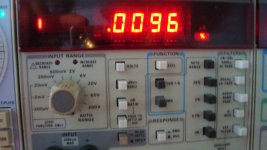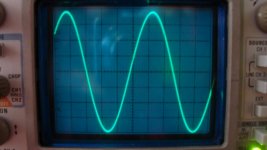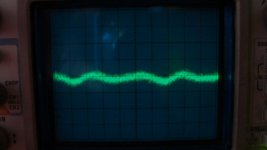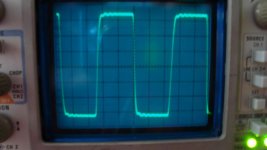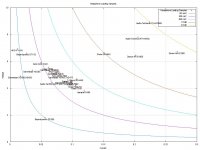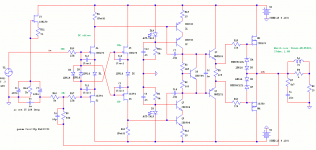Just thought I'd open a thread about my project I showed @ BAF. I was in the Tesla room. Phones I used were the Denon AH-D2000.
The circuit is rather straight forward except for the diff pair. I'm trying something different.
Input transformers are Jensen JE-11P-1 not shown in the schem. The amp can drive speakers just fine, too. Idle current right now is at a beefy 1.3A
The circuit is rather straight forward except for the diff pair. I'm trying something different.
Input transformers are Jensen JE-11P-1 not shown in the schem. The amp can drive speakers just fine, too. Idle current right now is at a beefy 1.3A
Attachments
Last edited:
At 1.5Vrms 1kHz output into 8 ohms (real speaker), 0.0095% THD+N. Rockin'  Residual shown as mostly noise, too. I forget the residual of my sine generator, but it's something around 0.0035%
Residual shown as mostly noise, too. I forget the residual of my sine generator, but it's something around 0.0035%
10kHz Square wave performance not so good, though. A bit of ring, but I'm working on it in spice to see how to arrest the 1MHz ring without losing slew.
 Residual shown as mostly noise, too. I forget the residual of my sine generator, but it's something around 0.0035%
Residual shown as mostly noise, too. I forget the residual of my sine generator, but it's something around 0.0035%10kHz Square wave performance not so good, though. A bit of ring, but I'm working on it in spice to see how to arrest the 1MHz ring without losing slew.
Attachments
1.3 A bias. (!) If I read the schematic correctly, |V+|+|V-|= 30 V so that's ~40W idle.
Those Denon cans are 106dB/mW and 25 ohm. 50 mA bias would be more than sufficient to maintain class A operation under real world listening conditions.
What is you rationale for driving them with such a high power amplifier?
I'm curious as I went through much the same thing recently, and came up with a much, much lower figure.
Those Denon cans are 106dB/mW and 25 ohm. 50 mA bias would be more than sufficient to maintain class A operation under real world listening conditions.
What is you rationale for driving them with such a high power amplifier?
I'm curious as I went through much the same thing recently, and came up with a much, much lower figure.
Spot on rjm... 40W. The fins are big enough. The TO3s cook to 41C.
1) mainly for fun to see how far it goes. I like seeing how the Hitachis back off 10% once they warmup. Gotta love that negative tempco
2) it was meant mainly for headphone, but will also be used with some small speakers, too.
3) I reversed it down to 350Ma idle per channel calculating for 2W output, rather than thinking max SPL. See the chart (hope it is readable) ->
1) mainly for fun to see how far it goes. I like seeing how the Hitachis back off 10% once they warmup. Gotta love that negative tempco
2) it was meant mainly for headphone, but will also be used with some small speakers, too.
3) I reversed it down to 350Ma idle per channel calculating for 2W output, rather than thinking max SPL. See the chart (hope it is readable) ->
Attachments
I will be waiting to audition the next beta
You will be the first to see it. I really can't do much about avoiding you if I wanted to.
See the chart (hope it is readable) ->
I see an I-V plot with constant-power curves indicated, but the individual headphones would plot as straight lines on such a graph (as V = I Zheadphone) rather than individual points, unless a output level was specified (120 dB for example) which I don't see written anywhere.
My calculation (for the record) went as follows:
Typical line level is 2 V rms. Max. My "very loud" volume setting on the headphone amp, for line level input with the HD600's, is such that together with the amp gain, the total signal gain is unity. So the "typical music power" (-20 dB) is 0.1 mW, with clipping peak (0 dB) at 13 mW. For 16 ohm phones, the current required is 6 times larger but the power will be the same provided the sensitivity is comparable. Some headphones are less sensitive than average, but a push-pull class A amp can always slide into class AB to cover the peaks.
So most of the time I'm using less than 1 mW, but 10-20 mW could conceivably be required on transients. 50-100 mW is already overkill, but diy'ers are rarely put off by that word.
Enjoy your amp, it looks like fun.
Listening level I don't like to exceed has 5V peaks (that's 10Vp-p if you're counting) and measures around 1Vrms into my 25 ohm Denons. That's 200ma peaks.
From that, calculate power if you want to, but I've never found power as a measure of any significance except to derive back to V and I, which are the important ones. I called a local sound company once to rent some amps and spec'd him volts at a minimum load and he couldn't understand me until I talked watts.
I don't exceed that level because I can hear the distortion of my crappy CD player smearing the mids
Guess what my next project is?
From that, calculate power if you want to, but I've never found power as a measure of any significance except to derive back to V and I, which are the important ones. I called a local sound company once to rent some amps and spec'd him volts at a minimum load and he couldn't understand me until I talked watts.
I don't exceed that level because I can hear the distortion of my crappy CD player smearing the mids
Guess what my next project is?
I'm out. I was planning to use some older Improved Sulzer regulators to power the headphone amp. The Sulzers can't supply that kind current.
I found I had a couple AD844 while rummaging through the stuff and a couple AD811. I guess I'll go the composite op amp route per Walt Jung on this one. I imagine coupled with the Sulzer power supply it should sound half decent.
I found I had a couple AD844 while rummaging through the stuff and a couple AD811. I guess I'll go the composite op amp route per Walt Jung on this one. I imagine coupled with the Sulzer power supply it should sound half decent.
I'm out. I was planning to use some older Improved Sulzer regulators to power the headphone amp. The Sulzers can't supply that kind current.
I found I had a couple AD844 while rummaging through the stuff and a couple AD811. I guess I'll go the composite op amp route per Walt Jung on this one. I imagine coupled with the Sulzer power supply it should sound half decent.
composite multiloop amps can have high loop gain which translates to high PSRR
further, you can sub regulate the input op amp supply which doesn't see any load with simple Zener shunts for even more ridiculous PSRR in the composite amp
silly complex PS regulation should be reserved for "simple" discrete circuits that have no PSRR of their own
- Status
- This old topic is closed. If you want to reopen this topic, contact a moderator using the "Report Post" button.
- Home
- Amplifiers
- Headphone Systems
- my Class-A MOSFET headphone amp
